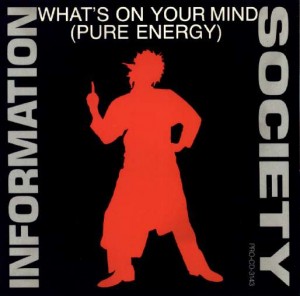Classic Mix Analysis: “What’s on Your Mind (Pure Energy)” by Information Society
Roey Shamir is a Recording-Mixing-Mastering Engineer, Musician and Producer based out of NYC — his credits include Al b Sure!, RUN DMC, SWV, Ronnie Spector, TKA, Mantronics, Roberta Flack, and Quincy Jones. He is co-owner of AREA51NYC, a recording studio and production suite in midtown Manhattan.
Songs and their respective mixing sessions are not all the same, at least not in my experience, hence I decided to write my mix analysis in several parts. I hope my words are read as a historic recollection, as I am trying to humbly do just that.
The Song
“What’s On Your Mind (Pure Energy)” by Information Society. Mixed on SSL 4000E- 48-track analog tape at Unique Recording Studio A, New York City. Produced by Fred Maher and Information Society (InSoc).
Because I worked on this album [the 1988-self titled Information Society] in the late 1980’s, I had to do some serious recollection to get all the details right.
Besides looking at my recall notes that were deep in storage, I reached out to my assistant on the project Angela Piva (Mary J. Blige , Naughty By Nature, Color Me Badd). This really was not a difficult thing to do as we are now married and living together. Carrying on with the recollection…
Construction Materials
This trend-setting record came to me to mix after a fellow producer, Craig Kafton, (who is also an early pioneer in EDM) recommended me to Fred and the band. They listened to some of my known mixes at the time and were eager for me to put my swerve on what they had already artfully created in preproduction and recording the tunes. They had gathered industrial sounds with their own portable recorder — I believe it was an F1 digital beta.
At that time I was one of the chief engineers at Unique where I did most of my mixing up until 1989. Studio A was my main room, although I also had tracked and mixed some well known records up in Unique’s Midi City Vintage Neve 80 series room.
The console setup was already done, as I have a method for placing all my favorite sends and returns as well as insert and line level patches that I would generally make. Unique had a plethora of great outboard classics, and I had developed a healthy couple of racks of my personal favorite, more rare stuff that most studios did not have — my “RoTools” as they were called.
Initial Pass
As usual, back then I did not listen to any reference tracks that they had previously made, but rather pushed up the faders and cycled the tape for a few plays as I got a vibe from the tracks as to which direction would be best for me to follow.
Mixing it!
Fred, being a brilliant drummer as well as producer, had selected really great drum samples with the band, so tweaking up a phat drum sound did not take me long.
After liking that, I muted them and then moved to the vocals and effects for the vocals tracks — EQ and dynamic compression, some Publison doubling (this was a popular technique that still works today where left channel is set a few cents flat with a short 3 ms delay and the right a few cents sharp with 7 ms delay. That is mixed via send–return along with the “dry” vocal channel. A well known version of this is heard on Phil Collins’ vocal for “In The Air Tonight”) and Quantec room simulator (a warm realistic “Hall” ), plus controlled delay throws using Lexicon pcm 42’s.
I dialed in the bass with some vintage Neve 1073 EQ and Neve compression, then I panned it hard left and brought a Yamaha Rev 1 chorus1 up on the right (of course, checking for mono compatibility with the Auratone mix checker).
The cello, which was a super Jupiter patch was really the main bass line and then I blended in all the keys, doing some dramatic volume swells on the pads.
Next I blended all the Star Trek samples including Spock, Bones and the Hunamana Gundas. We ran into an unexpected problem when the band found out that the samples of Star Trek had to be cleared! This was accomplished by getting Adam Nimoy involved, who liked the band’s music and later convinced his father Leonard Nimoy (Spock) to agree to the usage of his voice (“Pure Energy” “Illogical”). Not exactly sure how the clearance for Deforest Kelly’s voice was attained. “It’s worked so far but we’re not out yet.” Another degree of separation was my business partner at Area51NYC – Tony Drootin — is the Nimoy’s cousin.
The “Guitar” part:
Working unattended for the first few hours as I would always request from whomever I would work with, and being a guitar player and fan, I felt a need for some guitar timbre in the orchestration.
So naturally I patched a second version of the Rhodes pad into a line-matching box to bring it to -10db, then into the Rockman sustain-or rack mount. A popular Guitar channel that Tom Sholtz from legendary rock group Boston had invented, this was where the distortion that transformed the original pure Rhodes tone was generated, then back to the match (up to +4) and then to a channel on the SSL. I set that channel’s gate to external trigger, and then patched that trigger to a buss so that I could send more than one pre-fader drum part to trigger the gate. A combination of the hats, kick and snare triggered the gate, creating the rhythm for what became that groundbreaking sound, as well as the band’s signature sound. Not that the band did not already have its EDM direction,but that one element is what took it over the top and made their sound new and unique.
I set the gate for super-tight with fastest release, about 60 db of gain reduction – that was the most the SSL dynamics could do at that time. Now the resulting distorted rhythmic keyboard part was given some auto-panned shuffle delay to further groove it up.
Liking the result I soloed it up to further tweak it when the band (Kurt Harland, Paul Robb, James Cassidy) arrived to see how it was going. Before Kurt even said “Hello” he blurted out, “What the heck is that part? Where did it come from? We should use that!” (We did and then it later was lifted by MTV as a bumper that ran for years “new music, you hear it first…”)
A few years later my buddy Mic Murphy from the System was working with another well known mixer man – Keith Cohen on the left coast – and my name came up. They called me and Keith and I were introduced on the phone as he wanted to talk with me.
He told me how Information Society’s whole album had been his benchmark when he was mixing, especially when he mixed Paula Abdul’s stuff. [Editor’s Note: “What’s on Your Mind (Pure Energy)” went to No. 1 on the Dance chart, spent 39 weeks on that chart, and peaked at No. 3 on the Billboard Hot 100 pop chart.]
Mixdown
Another interesting story was when Shep Pettibone was working on a remix for the song, he called Fred asking where is the “guitar” part?
Fred replied, “Oh that was something Roey created in the mix. It ran live, and we did not print it on the multi.” (The multi was full, and the part partially sounded the way it did because it was not on tape.) Running live to the two track mixdown kept the tone zingy and edgy. I later explained it to Shep, but in the end he just sampled it from mix parts passes (stems) and then flew it in to the remix. The technique I used also inspired C&C Music Factory’s gated “guitar” track.
Moving back to that day, I then further automated the mix and used constructive criticism to tweak a mix everyone was satisfied with.
This was the first of eleven mixes we did to complete their self-titled 1988 album over the course of a little more than 15 days. We stayed locked out, and the majority of the patches and gear settings stayed the same, although used on different elements from song to song.
I would take ear and room breaks every 90 minutes or so, and we worked about 10 hours a day. Generally I got the mix close and printed refs for everyone to “check” outside the studio, then the next day perform any tweaks and print to half-inch tape. The remainder of that day I would get the next tune to a state of readiness, print some refs etc… until the album was done.
Yes Master
Next I went to see Herb Powers at his mastering room at the Hit Factory where he mastered my mixes, which he always did so tastefully and without ego. He would often do very minor and subtle adjustments, finding my work almost radio-club ready without him needing to do much to it.
It All Adds Up
Much has changed in the media and methods I use today, however they always have changed throughout my career — which started while I was still in high school in the Seventies. That being noted, I will be writing more mix analyses about some of those other sessions. Next time in Part Two: Run DMC – “Run’s House.”
— Roey Shamir
Please note: When you buy products through links on this page, we may earn an affiliate commission.









teknohed
February 4, 2013 at 7:56 am (11 years ago)Pure Energy is my favorite song. period. what a great article.
Bjorn Roche
February 4, 2013 at 7:26 pm (11 years ago)Awesome.
Dasystem
February 7, 2013 at 6:11 pm (11 years ago)awesome track. i used to hate it growing up cause the guidos would blast it but I guess they were onto something! Very Art of Noise sounding
Martin G. Choquette
February 8, 2013 at 8:30 am (11 years ago)Hated that song when it came out (was 16 at the time and all gloomy-doomy). Got to admit that 25 years later, it was a rather very good song. I won’t even dare comparing it to stuff that’s being made today. This was at least original.